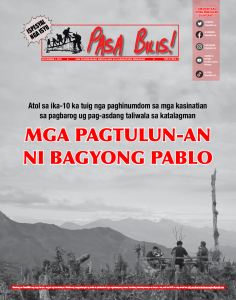Struggle and Recovery

“Mobilize all machineries in our areas of responsibility, mobilize the masses to solve hunger and overcome the hardship cause by Typhoon Pablo!”
This was our unity during the emergency meeting of the Party’s sub-section and the Red fighters in the area after Typhoon Pablo ravaged the three provinces of Southern Mindanao.
In merely two hours of the typhoon’s onslaught, the farms painstakingly cultivated by the masses were destroyed! Coconut trees, banana, corn, and fruits were felled; the sprawling sweet potatoes were wiped out, and all crops were ruined. A week after the typhoon, everything was the color of dull brown and the heat was unbearable. The weather was in turmoil.
But what did the reactionary government say after the typhoon? They blamed the calamity on poor people like us. They said that the damage was because of the stubbornness of the poor like small-scale miners and small loggers. Tsk, tsk, tsk. Our jaws dropped! Imagine? The nerve of them to blame the victims!
The root causes of the disaster were clear to us during the Party sub-section’s emergency meeting. It’s clear who ravaged all the big trees which would have been our defense during typhoons and landslides. Who was it that destroyed, excavated and flattened on a wide scale our mountains in order to mine gold and other minerals? To whom were these resources sold to and who benefitted from them? And they have the gall to tell us that large-scale mines like Russel Mining and plantations like those owned by Dole and Stanfilco are the road to progress and can save the Lumad from abject hunger?
After the typhoon’s two-hour onslaught, where was the supposed Philippine government when the people needed it? It is a good thing the New People’s Army is here. It is a blessing that the true government of the people exists here. The Party is here.
They were nearby when the disaster struck. They were the ones who took our children and elderly to safety from the houses that, in a matter of minutes, were blown away. When it seemed all hope was lost, it was the Red army that helped us rise above our predicament during the calamity.
In our meetings with the masses and the Red fighters, we took stock of the situation and the way forward was made clear. We can overcome the havoc wrought by Typhoon Pablo through united and collective struggle.
The extent of damage to the semifeudal and semicolonial economy already deep in crisis—from the scarcity of food to the loss of seedlings and food crops—will be impossible to resolve unless we do away with the small-producers mentality.
It took us decades to make our livelihood, and one night of exchanging ideas among members of the Party branch won’t solve our present problem. Neither can the self-serving so-called relief of the reactionary government or the multi-colored flags of non-government organizations with their cash-for-work programs. They already have programs like this in other barrios before the typhoon, but were they able to solve the poverty of the impoverished? And then there’s 4Ps [Conditional cash program by the reactionary government—Ed.], has that alleviated the suffering of the Filipino poor?
In our meeting, we detailed the immediate steps to take in order to solve hunger. Because this can’t be done individually, we resolved to undertake collective farming in our communal farms. We’re targeting that by the end of December, we will have already planted rice and corn (the seedlings that weren’t damaged by the typhoon) in our communal farm. We figured our seedlings will be enough for two hectares and our organization will still outsource for more.
We will open 10 to 20 more hectares so we can feed everyone in the community. We will strive for collective farming so we can harvest more. And later, we will farm 20 hectares more to achieve 40 hectares of rice field so that in one year, we will be able to provide for the rice consumption of the entire community.
Despite the heat and the rumbling of our stomachs, the collective in the Party branch and the members and officers of the mass organizations were all smiles after the meeting.
They said the typhoon was indeed terrible but it was that difficult situation that united us to vigorously carry out our tasks in the people’s war and lay the requisites for stalemate. That was already the Party’s call before the typhoon. Does the enemy believe the people’s war will regress because of the damage wrought by the typhoon? How very wrong they are. Big mistake, huge. Instead, we turned the calamity into an opportunity to build our people’s government.
Our next priority is the school for our children. Through our plan and concerted effort, we will repair our damaged schools. We already have a design for this and the SP* and the KRB* committee on Education have set the schedule on how to go about it. The Parent-Teachers Association is also helping. The GI sheets are ready, so are the nails, planks of wood, saw and hammers. These were all from the successful campaign that we carried out to demand reparations from the loggers that cut all the trees in our province. Our children will be able to start their classes after the new year.
The comrades’ design to guide our community’s recovery is both clear and practical, and it’s not merely for the time being but for long-term. In our discussions, fruit-bearing trees like cacao, coffee and rambutan mature in only two years. That jump-started our two-year plan for rehabilitation. How much more the fast-growing buyo-buyo and banana trees? In six months time, you can already tie a hammock between buyo-buyo trees or boil and eat the cardava variety of bananas. You can already take shade.
That became the basis for the design of our rehabilitation of farms, fruit trees and reforestation. The reforestation will be steered by the people’s militia and the revolutionary youth organization in the community. We will plant trees in watersheds. We will replant endemic trees such as lawaan and almaciga. We will also build nurseries for fruit trees like what other NPA units did in other areas.
In our Party branch and mass organization meetings, there are so many practical problems that we need to address in order for the rehabilitation campaign to take off, like farm tools and sources for seedlings for the communal farms. But we also agreed that for now, whatever tools that can be used to dig and however limited our seedlings on hand, we will make do. The communal farm accepts the work of everyone—kids, elderly, middle-aged, men or women.
Anyway, everyone’s share of the harvest will be based on his or her workpoints or one’s participation in the collective farming. We will set aside some portion of the yield for seed banking, another portion for the needs of the organization, a portion for emergency fund for the community and the rest will be divided to each individual according to his or her workpoints.
On our first day in the communal farm, we managed to open around three hectares and on the fourth day, we already planted rice. Around 60 to 100 people participated that time. It was fun! Though we could hear each other’s rumbling stomachs!
This coming May, come visit our community. It’s looking like a good yield for our rice field. We hope you can come by. In our community, you will find the masses overcoming the effects of the calamity through the struggle.
Great things are in store if we organize and struggle under proletarian guidance and leadership. We still have other campaign designs, plans and clear goals with regards to wellness, education and culture. True, it’s arduous and complicated, but in the difficult struggle, we know victory will be sweet.
* SP – Local Party branch
* KRB – Barrio Revolutionary Committee
____
First published in Pasa Bilis! July 2013 issue.
(Pasa Bilis! Special Issue, December 4, 2022)



